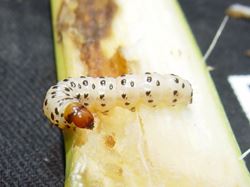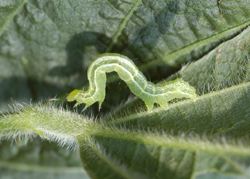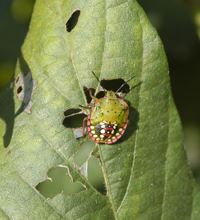|
MSU Sets New Thresholds For Row Crop Treatment
MISSISSIPPI STATE, MISS.
Mississippi producers who rely on Mississippi State University for information have some valuable new information to help them better time their insecticide applications in 2014.
Mississippi Agricultural and Forestry Experiment Station researchers spend a lot of time counting insect pests and calculating the damage they cause. They compile the data to determine at what point a producer should use insecticides to maintain a crop’s profitability.
Angus Catchot, row crop entomologist with the MSU Extension Service, said producers look to these MSU-established thresholds for authoritative information on when it is time to treat for insect pests or to trigger other crop treatments.
“We made a number of changes to thresholds this year,” Catchot said. “That’s a big deal. We don’t do it on a whim, but we base these thresholds on research data compiled carefully over several years.”
MSU scientists rolled out the new recommendations at the 2013 Row Crops Short Course in December, well in advance of the 2014 growing season.
Experiment Station entomologist Fred Musser gave specifics for stinkbugs and Southwestern corn borers. He also gave new recommendations for when to stop applying insecticides to soybean fields.
Existing thresholds for the Southwestern corn borer were based on egg and larval densities, and treatment was triggered when 25 percent of the plants were infected. Although the threshold is clearly defined, it is very hard to determine when it had been reached, Musser said.
“Searching for eggs is time consuming and requires trained and diligent search,” he said. “It’s easy to miss eggs even when you know what you’re looking for.”
MSU now recommends that producers set out pheromone traps to capture adult Southwestern corn borers. New thresholds were established using the number of adults in these traps.
“To have any kind of accurate prediction of losses based on egg counts, a producer would have to look at 10,000 plants,” Musser said. “The predictive quality of eggs and pheromone traps are fairly similar, but the effort going into making that decision is vastly different. For that reason, we’re recommending a pheromone trap threshold.”
MSU recommends that producers should treat for the first generation of the pest when they trap 50 adult Southwestern corn borers in a week or find 5 percent of the plants with egg infestations. When the second generation arrives, MSU recommends not treating a field unless 100 adults per trap per week are captured or there is a 10 percent egg infestation.
MSU recommends using a four-trap unit placed near, but not in the field, where there is good air flow to allow the pheromone to attract insects. Turn rows are ideal locations.
MSU also changed the thresholds for stinkbugs in soybean fields.
   (LEFT TO RIGHT) Mississippi State University is recommending producers spray for the Southwestern corn borer based on adult pests caught in traps rather than the number of egg infestations counted. This Southwestern corn borer is in the caterpillar stage. (LEFT TO RIGHT) Mississippi State University is recommending producers spray for the Southwestern corn borer based on adult pests caught in traps rather than the number of egg infestations counted. This Southwestern corn borer is in the caterpillar stage.
Photo by MSU Extension Service/Angus Catchot
Mississippi State University researchers changed the point at which they recommend soybean producers stop spraying for defoliating insects, such as soybean loopers. This soybean looper is in the caterpillar stage.
Photo by MSU Extension Service/Angus Catchot By Bonnie Coblentz
Mississippi State University recently changed its recommendations on when to treat for stinkbugs in soybeans. This Southern green stinkbug is in its nymph phase. Photo by MSU Extension Service
“By the time we get to R6, the beans are already filled in and we don’t see actual yield losses,” Musser said. “There are some quality losses, but it is rare that will make an economic impact. For that reason, we have raised the threshold to 20 stinkbugs per 25 sweeps from the R6 to R6.5 maturity stages. When beans reach R6.5, we are recommending a termination of insecticides targeting stinkbugs.”
Reproductive stage 6, or R6, is when soybean seeds are almost mature. Seeds are fully mature at reproductive stage 8, or R8.
The final change addressed the point at which producers stop spraying insecticides to control insects that defoliate soybeans. MSU still recommends producers spray insecticides when soybeans at reproductive stages are 20 percent defoliated by insects such as soybean loopers. Researchers now recommend no insecticides be sprayed after the R6.5 maturity stage, because results from four Mississippi trials from 2009 to 2011 indicate there is no economic benefit in applications after this point.
“The yield loss from defoliation during R6 is less than at earlier growth stages, so if defoliation has not exceeded 20 percent by R6.5, it will not reach economically damaging levels before the soybeans are mature enough to harvest,” Musser said. ∆
|
|